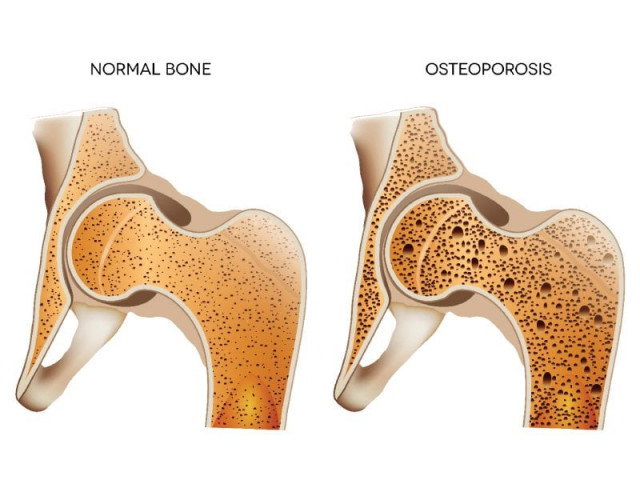Osteoporosis: Breaking back
Osteoporosis leaves your bones brittle and prone to fractures — even without your knowledge.

Osteoporosis leaves your bones brittle and prone to fractures — even without your knowledge. DESIGN : MUNIRA ABBAS
Almost 97% of women aged 75-84 years and 55% aged 45-54 years suffer from this disease states a study titled ‘Dietary Calcium Intake, Vitamin D Status, and Bone Health in Postmenopausal Women in Rural Pakistan’ published in the Journal of Health, Population and Nutrition in 2011. According to the report prepared by the International Osteoporosis Foundation, titled ‘The Asian Audit: Epidemiology, costs and burden of osteoporosis in Asia 2009,’ 9.91 million people in Pakistan suffer from osteoporosis.
Commonly affecting the hip bone, spine or wrist, the most common signs of the disease are fractures. In severe cases, even a slight forward bend can result in a fracture in the vertebra, leading to prolonged hospitalisation, limited mobility and increased incidence of depression.
The disease is a blend of both genetic and environmental factors and commonly occurs due to vitamin D deficiency and low intake of dietary calcium when younger. To reduce this risk factor gastroenterologist Dr Waseem Iqbal recommends, “Eat plenty of vegetables and fruit and get enough calcium and vitamin D to make your bones strong and healthy from childhood. Decrease sodium intake and increase weight bearing exercises like walking and running to prevent osteoporosis in the future.” Combined with a change in lifestyle that includes low caffeine, protein and tobacco intake, the health risk can be dramatically reduced.

Younger people are therefore best equipped to take necessary preventative measures and to peak bone mass before the age of 30. “It is known as a ‘silent killer’. Nutritional habits and lifestyle should be improved [when] young to prevent osteoporosis in the future,” says orthopedic and trauma surgeon, Pervaiz Iqbal. But while some risk factors are modifiable, others like low bone mineral density, a family history of osteoporosis and low estrogen levels in some women make the disease harder to prevent.
“Osteoporosis gets second place after heart disease as it affects 200 million women worldwide and causes over 200,000 fractures each year,” says Iqbal. Despite the staggering statistics, osteoporosis remains greatly under diagnosed and under treated and will continue to break backs until stringent measures are taken to control its spread.
Ayesha Saeed is an MPhil student in Lahore.
Types of Osteoporosis:
Primary type 1 or postmenopausal osteoporosis is widespread in women within 15 to 20 years of menopause.
Primary type 2 or senile osteoporosis mostly occurs in women or men after the age of 75.
Secondary osteoporosis can occur at any age and affects men and women equally.
Published in The Express Tribune, Sunday Magazine, March 2nd, 2014.



















COMMENTS
Comments are moderated and generally will be posted if they are on-topic and not abusive.
For more information, please see our Comments FAQ